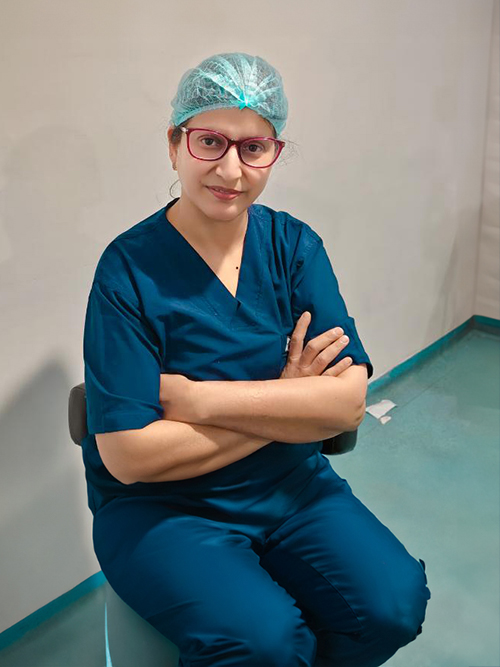Uveitis
Uveitis is a form of eye inflammation. It affects the middle layer of tissue in the eye wall (uvea).
In Numbers
Demographics
Technology / Innovation
LJEI is equipped with all the latest and rare Machines / Technology including AI.
Research
We preserve every single case study to handle any complex situation and publish research papers time to time.

Uveitis Treatment In India
What is Uveitis?
Uveitis warning signs often come on suddenly and get worse quickly. They include eye redness, pain and blurred vision. The condition can affect one or both eyes, and it can affect people of all ages, even children.
Possible causes of uveitis are infection, injury, or an autoimmune or inflammatory disease. Many times a cause can’t be identified.
Uveitis can be serious, leading to permanent vision loss. Early diagnosis and treatment are important to prevent complications and preserve your vision.
Uveitis Symptoms
- Eye redness
- Eye pain
- Light sensitivity
- Blurred vision
- Dark, floating spots in your field of vision (floaters)
- Decreased vision
Symptoms may occur suddenly and get worse quickly, though in some cases, they develop gradually. They may affect one or both eyes. Occasionally, there are no symptoms, and signs of uveitis are observed on a routine eye exam.
The uvea is the middle layer of tissue in the wall of the eye. It consists of the iris, the ciliary body and the choroid. When you look at your eye in the mirror, you will see the white part of the eye (sclera) and the colored part of the eye (iris).
The iris is located inside the front of the eye. The ciliary body is a structure behind the iris. The choroid is a layer of blood vessels between the retina and the sclera. The retina lines the inside of the back of the eye, like wallpaper. The inside of the back of the eye is filled with a gel-like liquid called vitreous.
What is the biggest cause of uveitis?
When does uveitis go away?
How do you treat uveitis permanently?
Can uveitis be cured permanently?
Who is at risk for uveitis?
Can you live a normal life with uveitis?
Can uveitis cause blindness?
How quickly can uveitis come back?
What age is uveitis most common?
Cornea Surgeon Dr. Vikas Mittal
Performed 3000+ Cornea Transplant Surgeries
My Approach
Lorem ipsum dolor sit amet, consectetur adipiscing elit. Phasellus vehicula ac nisl ut euismod. Vestibulum id magna rutrum, efficitur neque non, congue ante. Fusce ac finibus sem. Sed nec purus sagittis, euismod neque ac, ultrices lacus. Aenean iaculis lacinia magna, id elementum dolor malesuada sit amet. Sed at mollis velit. Suspendisse cursus, velit eu
Lorem ipsum dolor sit amet, consectetur adipiscing elit. Phasellus vehicula ac nisl ut euismod. Vestibulum id magna rutrum, efficitur neque non, congue ante. Fusce ac finibus sem. Sed nec purus sagittis, euismod neque ac

Type of Uveitis
The type of uveitis you have depends on which part or parts of the eye are inflamed:
Anterior Uveitis
Intermediate Uveitis
Posterior Uveitis
Panuveitis
Uveitis In Numbers
Check that how many patients come for Diabetic Retinopathy treatment and various tests related to Diabetic Retinopathy.
Diabetic Retinopathy
Green LASER Operations
Anti VGEF Injections
OCT Tests
Our Retina Specialist, Dr. Ruchi Mittal is an alumna of the esteemed Sankara Nethralaya
Causes of Uveitis
In about half of all cases, the specific cause of uveitis isn’t clear, and the disorder may be considered an autoimmune disease that only affects the eye or eyes. If a cause can be determined, it may be one of the following:
1- An autoimmune or inflammatory disorder that affects other parts of the body, such as sarcoidosis, systemic lupus erythematosus or Crohn’s disease.
2- Ankylosing spondylitis, a type of inflammatory disease that can cause some of the bones in the spine to fuse, leading to back pain. Uveitis is one of the most common complications of ankylosing spondylitis.
3- An infection, such as cat-scratch disease, herpes zoster, syphilis, toxoplasmosis or tuberculosis.
4- Medication side effect.
5- Eye injury or surgery.
6- Very rarely, a cancer that affects the eye, such as lymphoma.

Technology @ LJEI
Technology Available For Uveitis Treatment at LJEI
LJ Eye Institute employs ultra-advanced technologies for Diabetic Retinopathy Procedures.
- ZEISS Optical Coherence Tomography (OCT) Systems
- ZEISS Clarus 700 | Fundus Photography
- Argon LASER
- Green LASER
- Intraocular Injections
- Low-energy laser pulses
- YAG laser

Still Have Questions?
Cornea Patients Feedbacks

I have operated of my sister(chetna) eye Injection by Dr Ruchi Mittal under STAR insurance from LJEye Institute,Ambala. Dr Ruchi Mittal is a best Retina doctor. Insurance team is a best team of LJ. Staff is best. Thankyou.

cracker injury and retina problem taking treatment from dr. ruchi mittal. she makes us so comfortable and provide us best treatment. my son feeling better. cooperative staff and clean environment.

I’m taking treatment for retina problem from dr. Ruchi Mittal. She is the best doctor for retina. I’m happy. Everything is good in this hospital staff and all.

Its a great experience here and such a nice staff here as my mother have retinal surgery done by Mrs. Ruchi Mittal

I had visited lj eye institute ambala for retina checkup and it’s really fruitful. Thank u Dr. Ruchi mittal.

My retina treatment is going good here.dr. ruchi Mittal is best doctor for retina in haryana.
Empanelments



















